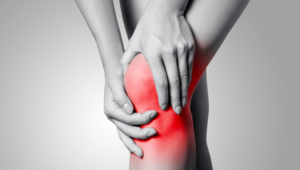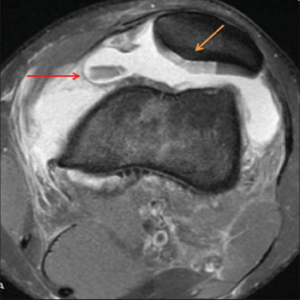How Does This Happen?
A patella dislocation can occur due to a number of reasons. You can think of patella dislocations as occurring in two types of people. First, someone who had an injury to the knee and it forced the patella out of its joint. Second, someone who has “loose joints” and the patella slides in and out frequently – or at least more than once or twice.

Photo Credit: MedScape.com
The first group may have a trauma to their knee such as being hit playing soccer, basketball, or football. This injury to the knee can cause the patella to move out of its joint, and in most cases will come right back in on its own. This is frequently referred to as a “dislocation” or “subluxation” event.
In the second group, you may simply have very loose ligaments or tendons that normally hold the patella in place, but due to their laxity the knee frequently dislocates or subluxates and causes pain.
For both groups, you may have subtle abnormalities in your anatomy that put you at risk for having one of these dislocation or subluxation events.
Will It Happen Again and Should I Be Worried?
In some instances, if this is the first time you have dislocated or subluxated your patella, it may not happen again. However, if there is significant damage caused by the dislocation or subluxation it is possible it may happen again. Your surgeon should evaluate you in clinic and will likely get an MRI to evaluate the degree of damage. If there is a significant amount of damage, especially of the cartilage, you may be indicated for surgery to fix this.
Do I Need Surgery?

Photo Credit: http://orthopaedics360.com.au/
If this is the first time you have had a dislocation or subluxation of the patella you may not need surgery. However, if there is evidence of damage to the bone, ligaments, or cartilage on MRI you may need surgery. You should meet with your surgeon and review the MRI together to discuss this further. Additionally, if this is a recurring problem you may need surgery to prevent you from creating further damage to the knee.
What Is It Like After Surgery?
After surgery you will typically go home that day. For the first 3-5 days your knee will be sore and a bit swollen from the surgery. During this time you will be applying ice to the knee, elevating your leg to help with swelling, and will need to take pain medications as needed for the first 3-5 days. You will be able to walk with crutches putting some weight on your knee immediately. You will also start physical therapy after the first week to begin strengthening your leg after surgery and to make sure you keep your normal range of motion.
Can I Go Back To Sports After Surgery?

Photo Credit: BroncoSports.com
The goal would be to get you to return to your previous sport at your previous level. The post-operative rehabilitation process will be key to getting your knee reconditioned to return to your sport. A typical timeframe to achieve a return to sport is 10-12 weeks depending on the sport you play.
When Do I Seek Further Evaluation?
If you have had a dislocation or subluxation event due to a trauma or have had recurring dislocation or subluxation events you should see a Sports Medicine trained physician not only to assess the injury but to prevent further injury to your knee. A thorough evaluation and discussion of your treatment options should be made by you, your parents (if you are less than 18), and your trainer/coach (if you are an athlete).
To set up an appointment for further evaluation, please call (208) 336-8250.